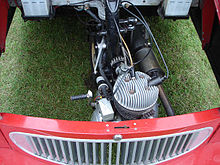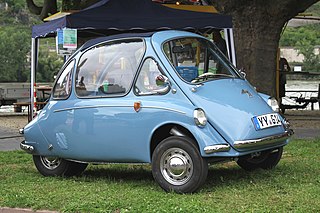
A bike-engined car is a small or light weight car that is powered by an engine that was designed for use in a motorcycle.

A bike-engined car is a small or light weight car that is powered by an engine that was designed for use in a motorcycle.

Early examples of bike-engined cars include the 1948 Invacar and the 1949 Bond Minicar, both of which were designed as basic, low-cost transportation.
Modern motorcycle engines are often available with higher specific outputs than car engines, which provides a performance advantage in a lightweight car. The motorcycle's sequential gearbox is often fitted with the engine, allowing for fast gearshifts.
The drawbacks of using motorcycle engines in cars are the lack of reverse gear and reduced torque output at low RPM.
Performance models of bike-engined cars are often based on the Lotus 7-type kit cars.
In the United Kingdom, the 750 Motor Club runs a national race series for cars powered by road going motorcycle engines (RGB series). Radical Sportscars also runs a racing series for its bike-engined cars.
In the United States, the Lites 2 category of IMSA Prototype Lites [1] (formerly IMSA Lites) consists of cars using a Kawasaki motorcycle engine.
The Formula BMW junior racing series (often used as a stepping stone towards Formula One) used open-wheel cars powered by the BMW K1200RS motorcycle engine.
These are all Suzuki Hayabusa-engined cars. The Hayabusa engine has also been used in Radical Sportscars, the Caterham Seven and Ariel Atom. [3] [4] [5] [6]

Microcar is a term often used for the smallest size of cars, with three or four wheels and often an engine smaller than 700 cc (43 cu in). Specific types of microcars include bubble cars, cycle cars, invacar, quadricycles and voiturettes. Microcars are often covered by separate regulations to normal cars, having relaxed requirements for registration and licensing.

Suzuki Motor Corporation is a Japanese multinational mobility manufacturer headquartered in Hamamatsu, Shizuoka. It manufactures automobiles, motorcycles, all-terrain vehicles (ATVs), outboard marine engines, wheelchairs and a variety of other small internal combustion engines. In 2016, Suzuki was the eleventh biggest automaker by production worldwide. Suzuki has over 45,000 employees and has 35 production facilities in 23 countries, and 133 distributors in 192 countries. The worldwide sales volume of automobiles is the world's tenth largest, while domestic sales volume is the third largest in the country.

Berkeley Cars Ltd was a British car manufacturer based in Biggleswade, Bedfordshire. The company produced economical sporting microcars with motorcycle-derived engines from 322 cc to 692 cc and front wheel drive between 1956 and 1960. About 4,100 cars had been sold before bankruptcy in 1960.

The Suzuki GSX1300R Hayabusa is a sports motorcycle made by Suzuki since 1999. It immediately won acclaim as the world's fastest production motorcycle, with a top speed of 303 to 312 km/h.
Nikasil is a trademarked electrodeposited lipophilic nickel matrix silicon carbide coating for engine components, mainly piston engine cylinder liners.
RPE RP-V8 is the name of a naturally-aspirated V8 engine series developed by Radical Sportscars in Peterborough, England for use in the SR8 sportscar. The design is loosely based on the 1.3 litres (79.3 cu in) inline-four engine produced by Suzuki for their Hayabusa motorcycle. The company have designed their own cylinder block and use existing Suzuki cylinder heads. The two cylinder banks are inclined at 72-degree angle. Lubrication is provided by a dry sump system. The engine is mated to a purpose-built transaxle designed by Quaife.

A sport bike, sports motorcycle, or sports bike is a motorcycle designed and optimized for speed, acceleration, braking, and cornering on asphalt concrete race tracks and roads. They are mainly designed for performance at the expense of comfort, fuel economy, safety, noise reduction and storage in comparison with other motorcycles.

The Westfield Megabusa is a British-made Lotus Seven inspired car with a 1,299 cc motorcycle engine, taken from the Suzuki Hayabusa, and six-speed sequential gearbox. The Megabusa is a road legal track car in at least some European countries.

A motorcycle engine is an engine that powers a motorcycle. Motorcycle engines are typically two-stroke or four-stroke internal combustion engines, but other engine types, such as Wankels and electric motors, have been used.

The Ariel Atom is a road-legal high performance open-wheel car made by the British Ariel Motor Company based in Crewkerne, Somerset, England, and under license in North America by TMI Autotech, Inc. at Virginia International Raceway in Alton, Virginia.
Ariel Motor Company Limited is a British, low-volume performance motor vehicle manufacturing company in Crewkerne, in Somerset, England.

The Westfield XTR2 is an ultralightweight, two-seater sports car manufactured by Westfield Sportscars Limited, of West Midlands, UK. It features a lightweight steel tubular spaceframe chassis, and the 170 hp (127 kW), 1299 cc Suzuki Hayabusa 4-cylinder engine, mated to a 6-speed sequential gearbox. Performance upgrades are available. However, it lacks a windshield, side doors, roof, and is virtually devoid of interior luxury. As a result of this simplicity, the car only weighs between 410–440 kilograms, depending on configuration. By achieving an extremely high power-to-weight ratio, it has been intended primarily as a car to be used on the race track. However, it is still legal for road use. The Westfield XTR2 is a member of the Bike Engined Car (BEC) class of vehicle that are becoming very popular at Track Days.
The Sauber C7 was a Group C prototype race car built by Swiss manufacturer Sauber for competition in the World Sportscar Championship.

IMSA Prototype Challenge was a racing series featuring two classes of single-seat prototype cars racing simultaneously. The series was sanctioned by the International Motor Sports Association (IMSA). Most races were held in support of the WeatherTech SportsCar Championship. The series raced LMP3 class prototype sportscars. The cars have grown in size and speed since its 2006 introduction, starting from four-cylinder and motorcycle powered race cars to large V8 powered cars. Each race was 1 hour and 45 minutes long apart from the season opening 3 hour race at Daytona International Speedway.

The Zolfe Orange is a car announced at the Autosport show in January 2006 built by Zolfe in Redditch, Worcestershire, United Kingdom.
Mills Extreme Vehicles (MEV) is a kit car design and manufacturing company based in Gloucestershire, England, founded in 2003 by Stuart Mills and Julie Wilson.
Radical Performance Engines (RPE) are an engine manufacturer of performance engines from the United Kingdom. The company mainly works with Suzuki motorcycle based engines, and they are the sole engine manufacturer for Radical Sportscars.
Forced induction in motorcycles is the application of forced induction to a motorcycle engine. Special automotive engineering and human factors considerations exist for the application of forced induction with motorcycles, compared to other forms of motorized transportation.
{{cite web}}: Missing or empty |title= (help)[ dead link ]